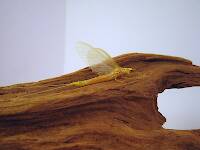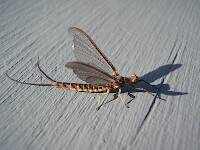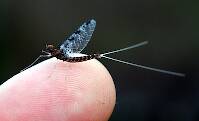
Hex Mayflies
Hexagenia limbata
The famous nocturnal Hex hatch of the Midwest (and a few other lucky locations) stirs to the surface mythically large brown trout that only touch streamers for the rest of the year.
Featured on the forum

Some characteristics from the microscope images for the tentative species id: The postero-lateral projections are found only on segment 9, not segment 8. Based on the key in Jacobus et al. (2014), it appears to key to Neoleptophlebia adoptiva or Neoleptophlebia heteronea, same as this specimen with pretty different abdominal markings. However, distinguishing between those calls for comparing the lengths of the second and third segment of the labial palp, and this one (like the other one) only seems to have two segments. So I'm stuck on them both. It's likely that the fact that they're immature nymphs stymies identification in some important way.

Troutnut is a project started in 2003 by salmonid ecologist Jason "Troutnut" Neuswanger to help anglers and
fly tyers unabashedly embrace the entomological side of the sport. Learn more about Troutnut or
support the project for an enhanced experience here.
Quillgordon on Apr 24, 2007April 24th, 2007, 1:09 pm EDT
Why do mayflies change( molt) from the subimago(semi-adult) state to imago (fully adult)?
I know they need time to develop sexually, but why do they have to molt for the transformation to take place?
I believe mayflies are unique to this process.
Is there a simple answer, or is it too complicated to explain!
just curious!
I know they need time to develop sexually, but why do they have to molt for the transformation to take place?
I believe mayflies are unique to this process.
Is there a simple answer, or is it too complicated to explain!
just curious!
Flyfishing is a state of mind! .............. Q.g.
C/R........barbless
C/R........barbless
Taxon on Apr 24, 2007April 24th, 2007, 1:38 pm EDT
John-
I believe that is simply the way they evolved. In other words, I suspect no one really knows. However, as with any of my outrageous opinions, I stand ready to be corrected.
I believe that is simply the way they evolved. In other words, I suspect no one really knows. However, as with any of my outrageous opinions, I stand ready to be corrected.
Quillgordon on Apr 24, 2007April 24th, 2007, 2:15 pm EDT
Taxon,
I found this, but it was just to technical for me to decipher.
I skipped most of it and went to the conclusions.
What do you conclude ?
The Mayfly Subimago
I found this, but it was just to technical for me to decipher.
I skipped most of it and went to the conclusions.
What do you conclude ?
The Mayfly Subimago
Flyfishing is a state of mind! .............. Q.g.
C/R........barbless
C/R........barbless
Konchu on Apr 24, 2007April 24th, 2007, 2:55 pm EDT
The subimago stage is unique among winged insects. It might be a holdover from ancient relatives. Extinct orders may also have had similar stages.
The sub stage is "unwettable." It helps the winged form escape surface tension of the water.
The sub stage is "unwettable." It helps the winged form escape surface tension of the water.
Troutnut on Apr 24, 2007April 24th, 2007, 3:17 pm EDT
That PDF is what I was going to recommend to answer this question, too. :) Konchu gives a nice summary of the main points.
Jason Neuswanger, Ph.D.
Troutnut and salmonid ecologist
Troutnut and salmonid ecologist
Quillgordon on Apr 26, 2007April 26th, 2007, 5:32 am EDT
I believe the article was written in 1988. I thought maybe there was an update on the subject. It seems some believe it has 'primitive origins' and others believe it is of more recent origins.
I thought maybe someone could expound on why it takes an addition molt to develope a 'fully sexual' adult.
Konchu...
Wouldn't this imply mayflies are a 'more recent evolution', since they change from subimago to imago, and they emerge from the water surface and not the shoreline?
I thought maybe someone could expound on why it takes an addition molt to develope a 'fully sexual' adult.
CHARACTERISTICS OF THE SUBIMAGO
The subimago of a mayfly is vastly different from the larva, whereas the
subimago and adult mayflies are quite similar and in a few species can be
difficult to tell apart. There is now little doubt that the subimagoa nd adult
represent two separate instars. In early publications, Lameere (40) and
Needhamet al (52) argued that the change from subimagot o adult was only
delamination of the outer layer of cuticle. This idea was refuted by Ide (29),
who showed critical cuticular differences as well as significant dimensional
510 EDMUNDS & McCAFFERTY
differences of some structures in the two forms, and by Taylor & Richards
who showed that complete cuticles exist in both forms and result from
complete molting cycles that include apolysis and ecdysis.
All male mayflies and most females molt from subimago to adult
Konchu...
Surface emergence would theoretically be possible once the subimago was
preadapted, or exaptated, to being unwettable because of surface microtrichia.
Two situations in the evolution of mayflies could have been related to a
shift from an ancestral land emergence to surface emergence, which is now by
far the predominantb ehavior. Ani ncrease in predatory pressure on land could
have favored surface emergence. A consideration of the kinds of habitat
transitions amongth e families of mayflies, in light of their relationships and
principal aquatic habitats, however, strongly suggests that the behavioral shift
was related to a shift from primarily still- or quiet-water habitats to runningwater
habitats where larval exit from the water would be problematic.
Wouldn't this imply mayflies are a 'more recent evolution', since they change from subimago to imago, and they emerge from the water surface and not the shoreline?
Flyfishing is a state of mind! .............. Q.g.
C/R........barbless
C/R........barbless
GONZO on Apr 27, 2007April 27th, 2007, 6:10 am EDT
Wouldn't this imply that mayflies are a 'more recent evolution'....
John,
I'll attempt a layman's explanation (which the experts may wish to modify, clarify, or dispute).
Mayflies (Ephemeroptera) are usually considered to be the most primitive (in structure) extant order of flying insects. They may also be the oldest, though some would apparently argue for the dragonflies (Odonata). Both orders were around in the late Carboniferous period, and were probably quite a bit larger than today due to the oxygen-rich environment. The retention of certain primitive characteristics makes the mayflies a model for the study of the evolution of insects, especially with regard to the evolution of flight and its relationship to metamorphosis.
The fossil record of Paleozoic mayflies (or precursors) demonstrates many shared chacteristics with modern mayflies, and the subsequent records demonstrate their evolutionary changes. Early examples had fore- and hind-wings of nearly equal length (later evolution reduced or eliminated hind-wings), and the adult winged form seems to have developed in several subimago instars. In other words, there were several immature winged molts preceding arrival at the fully-winged and sexually mature adult imago.
The peculiar form of metamorphosis (prometabolous) displayed by modern mayflies evolved through a reduction of these subimago molts, until only the single molt to a subimago was required for development of the winged stage. The molt from subimago to imago is still apparently required for full development of the male genitalia, claspers, and long grasping forelegs. A few modern mayfly females don't undergo this final molt. Female white flies (Ephoron) are an example of this.
Since all insects are believed to have evolved from a common terrestrial ancestor (an ametabolous form, which possibly evolved from crustaceans), the mayflies' unique form of metamorphosis, the development of wings, and the adaptation to an aquatic environment are "more recent evolution" when compared to the earliest insects on the long scale of geologic time. Nonetheless, mayflies are believed to be the most primitive living example of flying insects.
My apologies, in advance, for any mistakes or misinterpretations I may have presented in this simplified summary of the subject.
Best,
Gonzo
Quillgordon on Apr 27, 2007April 27th, 2007, 6:39 am EDT
Gonzo,
Thank you for your reply to a very complicated 'issue' being I am not an entomologist!
I thought it would be a good topic for our resident entomologists here.
I assume then, that no new papers have been written since that 1998 paper noted in that link.
John.....
Thank you for your reply to a very complicated 'issue' being I am not an entomologist!
I thought it would be a good topic for our resident entomologists here.
I assume then, that no new papers have been written since that 1998 paper noted in that link.
John.....
Flyfishing is a state of mind! .............. Q.g.
C/R........barbless
C/R........barbless
GONZO on Apr 27, 2007April 27th, 2007, 7:03 am EDT
You might want to look at Evolution of the Insects by David Grimaldi and Michael Engel (Cambridge University Press, 2005). It is supposed to be an up-to-date review of the subject.
Quillgordon on Apr 27, 2007April 27th, 2007, 7:12 am EDT
Would this be available at my local library, or would I have to buy it?
Flyfishing is a state of mind! .............. Q.g.
C/R........barbless
C/R........barbless
GONZO on Apr 27, 2007April 27th, 2007, 7:26 am EDT
Being a fairly recent title, I don't know. You might check with college or university libraries if your local library doesn't have it.
GONZO on Apr 27, 2007April 27th, 2007, 7:45 am EDT
PS--John, you might also try a web search for "The Primitive Characters of Extant Mayflies (Ephemeroptera)" by Zhou Chang-fa. Dr. Zhou's paper is short and understandable, even though it suffers a bit from a poor translation. (I assume.)
Quillgordon on Apr 27, 2007April 27th, 2007, 8:20 am EDT
Gonzo,
I found the website. I'll go thru this tonight with a few doses of BREW. Maybe I'll understand it better......... LOL...
How do you guys know all this stuff ??? I'm really impressed!
I lost contact with my old biology professor at the Univ. of Conn., so I can't get any help from him. He use to go to Oxford Univ. every year when I was a student at UConn. I offered to carry his luggage for him, but that didn't fly....... haha.
John
Conclusion
Because of above mentioned, we can conclude that the extant mayflies remain many primitive characters. They are relics of primitive Pterygota. Those make them the good materials for explaining the origin and evolution of Insecta.
I found the website. I'll go thru this tonight with a few doses of BREW. Maybe I'll understand it better......... LOL...
How do you guys know all this stuff ??? I'm really impressed!
I lost contact with my old biology professor at the Univ. of Conn., so I can't get any help from him. He use to go to Oxford Univ. every year when I was a student at UConn. I offered to carry his luggage for him, but that didn't fly....... haha.
John
Flyfishing is a state of mind! .............. Q.g.
C/R........barbless
C/R........barbless
GONZO on Apr 27, 2007April 27th, 2007, 9:09 am EDT
How do you guys know all this stuff???
The experts who post here know this stuff because they are trained and experienced professionals. As an amateur, my only excuse is unbridled curiosity about the things that interest me. I suspect that your inquiries are motivated by the same curiosity. :)
Quillgordon on Apr 27, 2007April 27th, 2007, 9:36 am EDT
You don't appear to be an amateur to me.....
You are well versed for someone who doesn't have a degree in entomology!
Maybe you or some else can answer this:
Scharfer(1975) suggested that the functional genitalia and wings of mayflies do not be mature simultaneously is a relic of ancient double moult: the wings occur first , after the second moult the genitalia are functional. While in other insects, they occur in only one moult. The selection pressure did not affect the ephemerous beings, the mayflies, greatly.
1. What does that last line mean about 'selection pressure?
Wing articulation and wing position
Without the flexing wing sclerites and muscles, Mayflies hold their wings vertically upwards when they are at rest, can not flex their wings backwards on the abdomen like the Neoptera.
This character is often cited as primitive one by many Entomologists. But according to Kukalová-Peck, this is not true.
2. What bothers me is sometimes they say they are 'primitive' and sometimes they say they aren't! Isn't it one or the other ? I know scientists can disagree, but shouldn't 'K&P' state its one or the other, not both?
Flyfishing is a state of mind! .............. Q.g.
C/R........barbless
C/R........barbless
GONZO on Apr 27, 2007April 27th, 2007, 10:03 am EDT
As I understand it, selection pressures are influences (from predators or environment, for example) that allow certain changes/adaptations to be promoted in evolutionary development. I assume that the line means that those pressures have not yet been sufficient to force mayfly evolution into a single molt that would produce a winged and sexually mature adult in both sexes.
With regard to the wing issue, mayflies' articulated, vertically held, non-folding wings were often considered to be one of their primitive characteristics. Apparently, Kukalova-Peck feels that this is not the primitive wing form, but some later modification of the primitive form. Rather than being strictly "primitive" or "non-primitive," modern mayflies retain some primitive characters along with more recent adaptations in the form of reductions or other modifications. (And some groups, like Siphlonuridae, are considered to be more primitive, while others are less primitive, like Polymitarcyidae.) Their retained primitive characteristics, however, mark them as one of the earliest forms of Pterygota (winged insects).
Perhaps one of the experts will chime in before I get into trouble here. (Please!) ;)
With regard to the wing issue, mayflies' articulated, vertically held, non-folding wings were often considered to be one of their primitive characteristics. Apparently, Kukalova-Peck feels that this is not the primitive wing form, but some later modification of the primitive form. Rather than being strictly "primitive" or "non-primitive," modern mayflies retain some primitive characters along with more recent adaptations in the form of reductions or other modifications. (And some groups, like Siphlonuridae, are considered to be more primitive, while others are less primitive, like Polymitarcyidae.) Their retained primitive characteristics, however, mark them as one of the earliest forms of Pterygota (winged insects).
Perhaps one of the experts will chime in before I get into trouble here. (Please!) ;)
Quillgordon on Apr 27, 2007April 27th, 2007, 11:39 am EDT
Hmmmmmm........ I understand what you are saying, but I'm having trouble putting it all together. Sort of like a puzzle that has
variable pieces.
I guess I have to read more an understand all the terms. Sometimes the articles are too technical and its difficult to get thru one sentence at a time.
Just looking at mayfly spinners (imago), and seeing how elegant they look, its hard for me to think they have 'primitive origins' compared to other not so elegant insects.
I have a book on 'Fishes', an introduction to Ichthyology, its too technical and boring, I can't get into it. I'm glad I never had to take the course! ..........FWIW.......
Thanks for your input.
variable pieces.
I guess I have to read more an understand all the terms. Sometimes the articles are too technical and its difficult to get thru one sentence at a time.
Just looking at mayfly spinners (imago), and seeing how elegant they look, its hard for me to think they have 'primitive origins' compared to other not so elegant insects.
I have a book on 'Fishes', an introduction to Ichthyology, its too technical and boring, I can't get into it. I'm glad I never had to take the course! ..........FWIW.......
Thanks for your input.
Flyfishing is a state of mind! .............. Q.g.
C/R........barbless
C/R........barbless
GONZO on Apr 27, 2007April 27th, 2007, 12:51 pm EDT
John, I don't think that "primitive" and "elegant" are mutually exclusive. After all, I doubt that mayflies could have survived for so long without some kind of evolutionary elegance. And the unique "dun" stage is a large part of what makes them a premier dry-fly insect and so cherished by fly fishers.
As for the complexities of the scientific material, I can only recommend plenty of patience and a good dictionary. ;)
As for the complexities of the scientific material, I can only recommend plenty of patience and a good dictionary. ;)
Konchu on Apr 27, 2007April 27th, 2007, 4:28 pm EDT
Several points:
Primitive is a relative term. Probably it should be applied to characteristics of organisms, rather than the organisms themselves.
I think some wingless insects continue to molt, even after they are sexually able. If I remember this correctly, then mayflies show a transition between the winged and non-winged insects. Anybody willing to back me up here or show otherwise? It's been awhile...
Finally, I notice that this thread started with a "why" quesiton. Science doesn't deal too well with whys. It deals more with hows. The old proximate vs. ultimate causes contrast. Science can detail a process and results, but the why is still floating in the ether somewhere. These kinds of questions spur confusion, curiosity and conversation and often drive natural science and theology (religion science) alike. Good stuff.
Primitive is a relative term. Probably it should be applied to characteristics of organisms, rather than the organisms themselves.
I think some wingless insects continue to molt, even after they are sexually able. If I remember this correctly, then mayflies show a transition between the winged and non-winged insects. Anybody willing to back me up here or show otherwise? It's been awhile...
Finally, I notice that this thread started with a "why" quesiton. Science doesn't deal too well with whys. It deals more with hows. The old proximate vs. ultimate causes contrast. Science can detail a process and results, but the why is still floating in the ether somewhere. These kinds of questions spur confusion, curiosity and conversation and often drive natural science and theology (religion science) alike. Good stuff.
Quillgordon on Apr 28, 2007April 28th, 2007, 2:06 am EDT
Gonzo...
Well, I'm glad they are unique. The 'spinners' are quite beautiful to look at aren't they!
Konchu.....
OK............
What 'selection pressures' might change the developement of mayflies that might eliminate the imago(spinner) state? :
1. 'Ph' water
2. Temperature
3. Streambed composition
I can see where 'selection pressures' may have been a factor in stonefly emergence (land as opposed to water), but I don't know what factor would change mayflies.
Just curious.....
John, I don't think that "primitive" and "elegant" are mutually exclusive. After all, I doubt that mayflies could have survived for so long without some kind of evolutionary elegance. And the unique "dun" stage is a large part of what makes them a premier dry-fly insect and so cherished by fly fishers.
Well, I'm glad they are unique. The 'spinners' are quite beautiful to look at aren't they!
Konchu.....
Finally, I notice that this thread started with a "why" quesiton. Science doesn't deal too well with whys. It deals more with hows.
OK............
As I understand it, selection pressures are influences (from predators or environment, for example) that allow certain changes/adaptations to be promoted in evolutionary development. I assume that the line means that those pressures have not yet been sufficient to force mayfly evolution into a single molt that would produce a winged and sexually mature adult in both sexes.
What 'selection pressures' might change the developement of mayflies that might eliminate the imago(spinner) state? :
1. 'Ph' water
2. Temperature
3. Streambed composition
I can see where 'selection pressures' may have been a factor in stonefly emergence (land as opposed to water), but I don't know what factor would change mayflies.
Just curious.....
Flyfishing is a state of mind! .............. Q.g.
C/R........barbless
C/R........barbless
Quick Reply
Related Discussions
Topic
Replies
Last Reply
8
Jan 7, 2009
by Dgracia
by Dgracia
1
Sep 9, 2008
by GONZO
by GONZO







